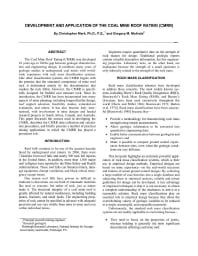Mining Publication: Development and Application of the Coal Mine Roof Rating (CMRR)
Original creation date: May 2007
Authors: C Mark, GM Molinda
NIOSHTIC2 Number: 20032090
Proceedings of the International Workshop on Rock Mass Classification in Underground Mining. Mark C; Pakalnis R; Tuchman RJ, eds., Pittsburgh, PA: U.S. Department of Health and Human Services, Public Health Service, Centers for Disease Control and Prevention, National Institute for Occupational Safety and Health, 2007 May; :95-109
The Coal Mine Roof Rating (CMRR) was developed 10 years ago to fill the gap between geologic characterization and engineering design. It combines many years of geologic studies in underground coal mines with worldwide experience with rock mass classification systems. Like other classification systems, the CMRR begins with the premise that the structural competence of mine roof rock is determined mainly by the discontinuities that weaken the rock fabric. However, the CMRR is specifically designed for bedded coal measure rock. Since its introduction, the CMRR has been incorporated into many aspects of mine planning, including longwall pillar design, roof support selection, feasibility studies, extended-cut evaluation, and others. It has also become truly international, with involvement in mine designs and funded research projects in South Africa, Canada, and Australia. This paper discusses the sources used in developing the CMRR, describes the CMRR data collection and calculation procedures, and briefly presents a number of practical mining applications in which the CMRR has played a prominent role.

NIOSHTIC2 Number: 20032090
Proceedings of the International Workshop on Rock Mass Classification in Underground Mining. Mark C; Pakalnis R; Tuchman RJ, eds., Pittsburgh, PA: U.S. Department of Health and Human Services, Public Health Service, Centers for Disease Control and Prevention, National Institute for Occupational Safety and Health, 2007 May; :95-109
- Diagnosing and Controlling Moisture-Sensitive Roof in Coal Mines
- Factors Influencing Intersection Stability in U.S. Coal Mines
- Geologic Hazards and Roof Stability in Coal Mines
- Ground Failures in Coal Mines with Weak Roof
- The Introduction of Roof Bolting to U.S. Underground Coal Mines (1948-1960): A Cautionary Tale
- Optimizing Secondary Roof Support with the NIOSH Support Technology Optimization Program (STOP)
- Overview of Coal Mine Ground Control Issues in the Illinois Basin
- Performance Characteristics for Welded Wire Screen Used for Surface Control in Underground Coal Mines
- Roof Screening: Best Practices and Roof Bolting Machines
- Support Design Procedures for Difficult Ground Conditions